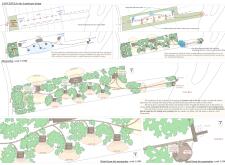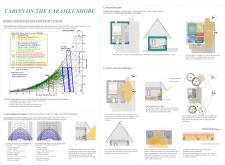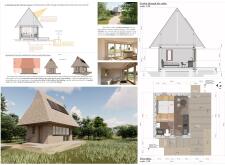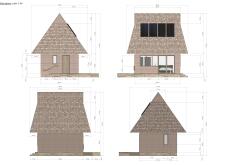5 key facts about this project
At its core, the project comprises a series of cabins strategically placed to maximize views of the Venta River while respecting the existing topography and vegetation. These cabins are designed to function as both individual retreats and communal spaces, fostering a sense of connection among visitors. The architecture is responsive to the landscape, with elements that allow for fluid transitions between indoors and outdoors, encouraging an immersive experience with nature.
The significance of this project lies in its representation of sustainable living and lifestyle choices that honor local tradition while catering to contemporary needs. By prioritizing the use of natural materials such as wood, stone, and glass, the design does not just serve aesthetic purposes but also aligns with eco-friendly principles. Wood framing and shingles not only provide warmth and an inviting appearance but also reflect a commonplace building tradition within the region, contributing to a sense of place. The stone foundations ensure durability and stability, grounding the structures while providing a visual contrast to the wood elements.
Key architectural details include expansive windows that invite natural light and provide unobstructed views of the surrounding landscape. The careful positioning of these openings reflects a design approach that leverages passive solar heating while facilitating ventilation. The cabin interiors are intentionally designed for comfort, with efficient layouts that include functional living spaces and cozy sleeping quarters.
The project also integrates communal areas that enhance social interaction among visitors. Shared amenities such as terraces, fire pits, and outdoor gathering spaces are strategically located to encourage community engagement, allowing visitors to connect with one another while enjoying the scenic views. This communal aspect of the design reinforces a sense of belonging and fosters shared experiences, making the architecture as much about building relationships as it is about creating individual retreats.
Unique design approaches employed in the project further enhance its appeal. The architecture prioritizes a human scale, making the cabins feel approachable and inviting. The design aesthetics draw upon traditional Latvian architectural forms, adapting them to meet present-day needs while retaining cultural significance. This careful consideration of local architectural history ensures that the project resonates with its geographical and cultural context.
The integration of vegetation into the site design not only enhances privacy but also contributes to the overall aesthetic and ecological health of the area. By utilizing native plant species, the project promotes biodiversity and strengthens the connection between the cabins and their surroundings. The landscape design serves as an extension of the architectural vision, creating additional layers of interaction and discovery for visitors.
In summary, "Cabins on the Caramel Shore" stands as a notable example of architecture that is deeply rooted in its context. It combines modern sensibilities with traditional inspiration, demonstrating a commitment to sustainability and community engagement. Readers are encouraged to explore the project presentation to gain deeper insights into the architectural plans, architectural sections, and architectural ideas that contribute to the overall vision of this endeavor. These elements collectively illustrate a thoughtful and comprehensive approach to architecture, designed for both living and experiencing nature.


























